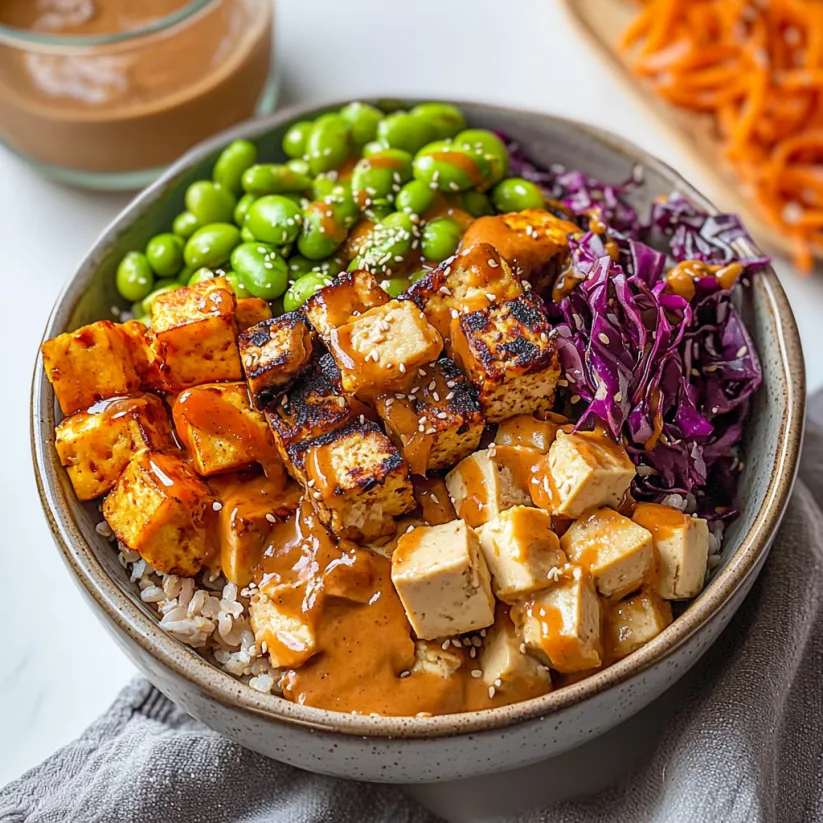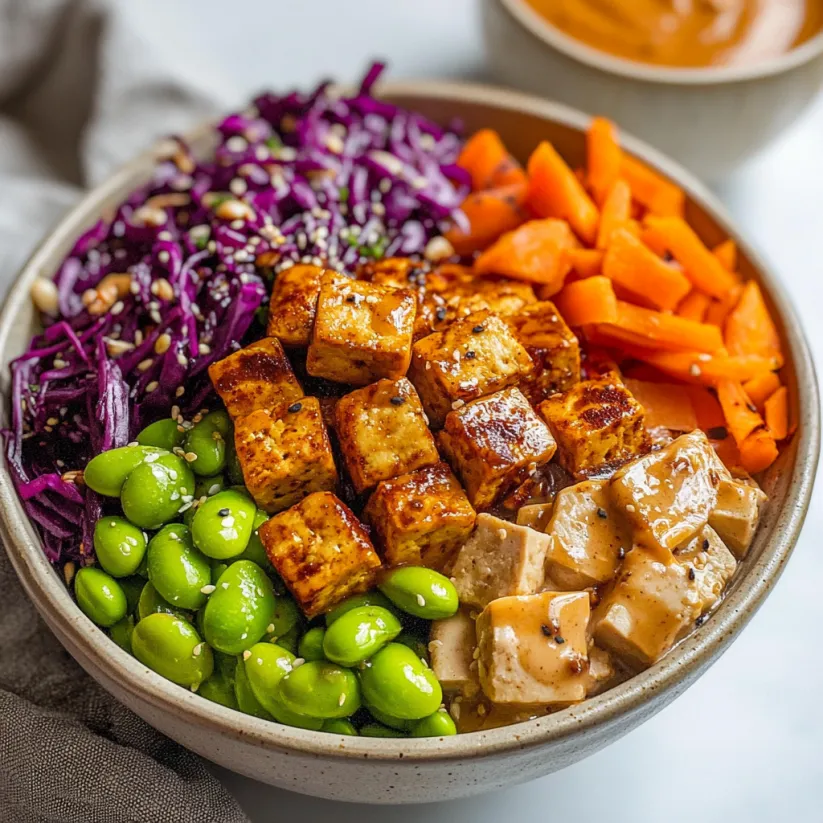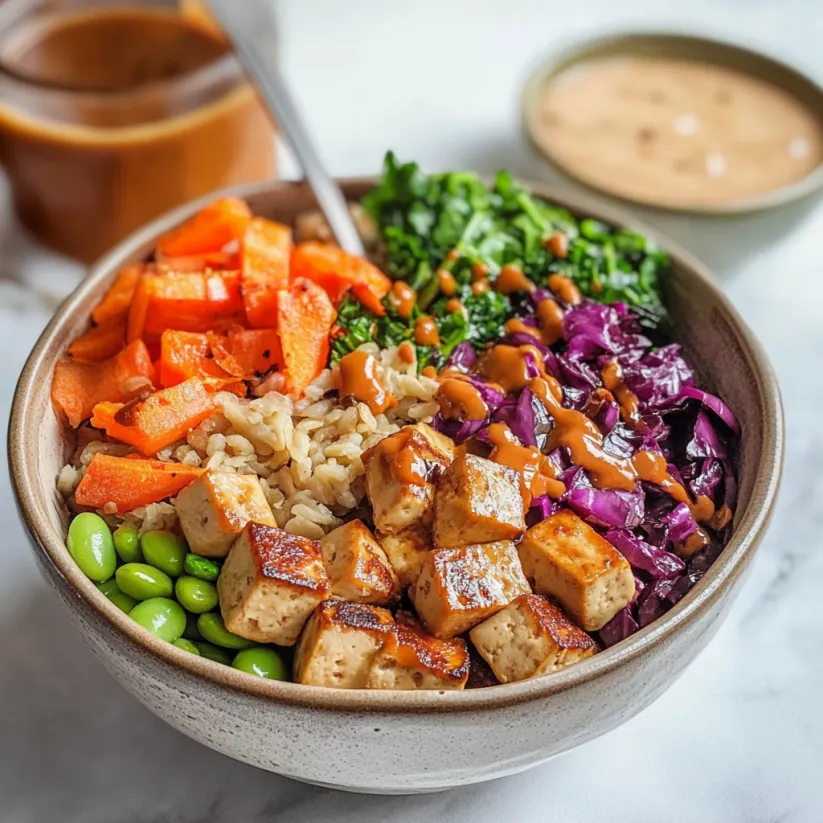 Save Pin
Save Pin
These tofu edamame buddha bowls are my go-to for a vibrant meal that packs in flavor and nutrients all in one bowl. They come together with pantry basics and simple fresh produce for a deeply satisfying vegan option loaded with plant protein and a creamy almond satay drizzle. Whenever I want something hearty but still fresh and colorful this recipe is a hands-down winner.
The first time I made these bowls I was craving takeout but wanted something homemade and nourishing. My family devoured them and now they are a meal prep staple in our house.
Ingredients
- Firm or extra-firm tofu: gives the best chewy cubes and holds shape during baking look for organic tofu with minimal ingredients
- Soy sauce or gluten-free tamari: adds essential umami when marinating tofu choose a naturally brewed version for depth of flavor
- Garlic powder: brings convenient garlicky kick without chopping opt for a fine and fresh-smelling powder
- Black pepper: boosts flavor and a little heat for the tofu freshly cracked will give the best results
- Almond butter: makes an ultra creamy satay sauce look for smooth almond butter with no added sugar
- Sweet chili sauce: offers sweet heat and rounds out the satay find brands with clean ingredients and no artificial colors
- Apple cider vinegar: adds mellow tang to balance the sauce
- Light coconut milk: thins the sauce with a hint of richness shake the can well before measuring for smooth consistency
- Cooked shelled edamame: brings color and heaps of protein buy bright green frozen pods or prepared from a trusted brand
- Red or green cabbage: adds crunch and body to the bowl choose a firm head with crisp tightly packed leaves
- Carrots: bring sweetness and bright color fresher carrots will shimmer when grated
- Cooked brown rice: anchors the bowl with filling whole grains opt for short or medium grain for best texture
Step-by-Step Instructions
- Bake the Tofu:
- Pat tofu dry and cut into even cubes about one inch each. Toss thoroughly in soy sauce black pepper and garlic powder until all sides are coated. Line a baking sheet and spread tofu in a single layer. Bake at 400 degrees Fahrenheit for 30 minutes flipping the cubes halfway. This helps develop the crisp and golden edges that make this bowl so satisfying.
- Roast the Cabbage:
- Roughly chop the cabbage into bite-size pieces. Place on a large baking tray and drizzle with just enough oil to coat. Sprinkle with salt and pepper for flavor. Spread out so the pieces are not overlapping. Roast in the hot oven for 30 to 40 minutes until the edges are turning brown and crisp. Roasting caramelizes the cabbage for natural sweetness and texture.
- Prepare Edamame:
- If using frozen shelled edamame bring a pan of water to a boil and add the beans. Cook for about 4 to 5 minutes until bright green and just tender. Drain well and set aside. This adds a vibrant pop of color and essential protein.
- Mix the Almond Satay Sauce:
- In a small bowl or jar whisk together almond butter sweet chili sauce tamari or soy sauce apple cider vinegar and light coconut milk. Continue whisking until smooth and pourable adding a splash of water if needed. A tightly sealed jar makes shaking everything together super easy for a creamy sauce.
- Assemble the Bowls:
- Divide the warm or cold cooked rice among four bowls. Top with sections of roasted cabbage grated carrot baked tofu cubes and cooked edamame. Drizzle each bowl generously with the satay sauce and add a little extra if you love sauce like I do. Serve right away or pack into containers for lunches through the week.
 Save Pin
Save Pin
Tofu has always been my favorite way to make a vegan meal heartier and I love how the baked cubes hold up even after a couple days in the fridge. My kids love dipping them in extra satay sauce just like nuggets and everyone stays full until dinner.
Storage Tips
Keep each component in a separate container in the fridge to maintain maximum freshness. The sauce can thicken as it chills so give it a stir and add a splash of warm water to loosen it before using. Assembled bowls store well for up to five days but I always wait to add the sauce until just before eating for the freshest flavors.
Ingredient Substitutions
Try swapping the almond butter for peanut butter or sunflower seed butter if there’s a nut allergy in your home. Broccoli florets or snap peas work beautifully in place of the cabbage for a seasonal twist. Jasmine rice or quinoa make a great swap for the brown rice base depending on what you have on hand.
Serving Suggestions
These bowls are perfectly filling as a main meal but they also shine with some quick pickled red onions or crunchy roasted peanuts on top. Fresh lime wedges and a sprinkle of cilantro bring out the flavors even more. You can double the sauce for dunking or save half for grilled veggies later in the week.
 Save Pin
Save Pin
Asian Buddha Bowls in Context
Buddha bowls are a cross-cultural favorite for those who want balanced nutrition in a single serving. The idea is to layer contrasting colors and textures in one bowl with grains protein vegetables and a punchy sauce. It is rumored the name comes from how round and full the bowl looks resembling the belly of a laughing Buddha.
Commonly Asked Questions
- → How do I make tofu crispy in these bowls?
To achieve crispy tofu, bake cubed tofu in a single layer at 400°F after tossing with soy sauce, garlic powder, and black pepper. Flip it halfway through baking for even texture.
- → Can I use other vegetables instead of cabbage and carrots?
Yes, feel free to substitute with your favorite veggies such as bell peppers, broccoli, or snap peas for added variety and taste.
- → Is the almond satay sauce spicy?
The almond satay has a hint of warmth from the sweet chili sauce, but you can adjust the spiciness by using more or less chili sauce to suit your preference.
- → How long will assembled bowls keep in the fridge?
Assembled bowls last up to 5 days if stored in airtight containers. For best texture, store the sauce separately and add it just before eating.
- → Can these bowls be eaten cold?
Yes, these bowls are delicious served cold, making them ideal for quick lunches. You may also reheat them if you prefer a warm meal.
- → Are these bowls gluten-free?
To ensure gluten-free bowls, use gluten-free tamari instead of regular soy sauce in both the tofu marinade and satay sauce.
